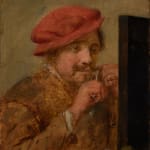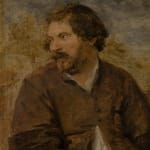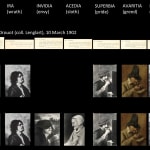
Adriaen Brouwer, "A Fat Man", oil on a single oak panel, Mauritshuis, The Hague (inv. no. 607).

Reconstruction of the original series by Brouwer, based on the copies by van Craesbeeck.
Adriaen Brouwer (Oudenaarde 1605/06 - 1638 Antwerp)
Further images
Although he may be considered one of the most important Flemish genre painters of the seventeenth century, preciously little is known about the life of Adriaen Brouwer. It has generally been assumed that he was born in 1605 or 1606 in Oudenaarde; however, as the cities’ birth records for the years 1603-1606 are missing, an exact date of birth cannot be established. Presumably, Brouwer was born between 1603-05 to Adriaen de Brouwere and Maria de Sutter, who had at least seven children. His father was probably active in the tapestry industry, as he was recorded as settling several debts with tapestry makers and dealers when selling his house in 1608. It appears the family moved to Gouda, as on the 15th of July 1614 the local mayor and aldermen granted permission to ‘Adrian de Brouwer van Oudenaerde in Vlaenderen’ to reside in the city. It is possible Adriaen senior was offered a job there by the tapestry producer Charles de Tavernier.
It is not known who Brouwer studied with during his time in Gouda. He next appears in a document dated 23 July 1626, as a witness to the statement by the painter Adriaen van Nieulandt and the art dealer Barend van Someren that they had visited the house of a local ribbon salesman in March 1625 to view 32 paintings, which were subsequently sold to the merchant Pieter Cornelisz Blyenberch, with van Someren acting as the middleman. The art historian Arnold Houbraken suggests in his Groote Schouburgh (1718-1721) that van Someren employed Brouwer at some point; in any case, with his extensive network of painters, engravers and art dealers the latter seems to have been an important intermediary for the young painter. After his death in 1632, van Someren’s extensive collection of prints and drawings was auctioned in 1635; Rembrandt bought several drawings by Brouwer at the sale.
While the document of 1626 places Brouwer in Amsterdam, that year he was also recorded as a member of De Wijngaertrancken, a chamber of rhetoric in nearby Haarlem that was very popular with local artists (Frans Hals was a member from 1616 until 1625.) It seems that by 1626 at the latest Brouwer had settled in Haarlem, as he also became a member of the local guild of St Luke. Houbraken states that Brouwer had been apprenticed to Frans Hals, although there are no archival records to substantiate this. As the painter left traces in quite a few inventories in Amsterdam, including in the art collections of several renowned art dealers and artists, it is possible that he also worked there for a while. In 1631 Brouwer moved to Antwerp, where he registered as a master of the local guild of St Luke in 161/32. That same year, he took in Jan-Baptist Dandoy as an apprentice, indicating that he intended to stay in the city for a longer period.
It appears Brouwer met with financial difficulties soon after his arrival, for on October 5 1632 his household effects were inventoried and handed over to his debtor, the silk dealer Jan van den Bossche. By late 1632 he presumably returned briefly to Haarlem to attend the baptism of his niece Adrianne (both Adriaen’s brother Hans and his sister Janneke had moved to Haarlem by then); he is next recorded on the 23rd of February 1633 ‘op den casteele van Antwerpen’ (i.e. in jail) confessing to owing a debt of 1600 guilders to the same Jan van den Bossche - a debt he promises to pay off with monthly payments in the form of paintings. However, the artist never did seem to get his finances in order, as by 1635 he was in arrears on his rent and had to promise his friend and landlord Paulus Pontius a brothel scene (‘een stucxken schilderije, wesende een Bordeeltken’) by his own hand to make up for the missed payments. Houbraken mentions that Brouwer spent some time in Paris after that, fruitlessly trying to make a living. Brouwer died sick and penniless in Antwerp in early 1638; he was buried on 1 February.
Brouwer’s repeated financial difficulties (which are well documented) combined with his preferred choice of subject - fighting, drinking and smoking low-lifes holed up in taverns - seem to have done his reputation little good. While his early biographers testify to the almost universal appreciation of his work, they also unfailingly point to his debauched and irresponsible lifestyle, painting him as a heavy drinker severely lacking in moderation, ‘with a pipe in his mouth in nasty piss-taverns’ (‘met ’t pijpken in den mont in slechte pis-taver[n]en’). However, identifying the artist with his subject like this does Brouwer little justice, as he was one of the best and most innovative seventeenth- century artists the Low Countries brought forth. Building on the tradition of Pieter Bruegel, he went on to create a wholly new stylistic idiom which effortlessly fused elements from both Northern and Southern Netherlandish painterly trends and fashions.
Although Brouwer is mostly known for his genre scenes, he also contributed greatly to the development of both portraiture and landscape painting. Already during his life Brouwer was hugely influential on his contemporaries: he was a true ‘artist’s artist’, whose work was collected by the greats of his day, including Rubens, whose estate inventory mentions no less than seventeen of Brouwer’s works. Furthermore, Rubens was profoundly influenced by Brouwer’s - startlingly modern - approach to painting landscapes, of which he owned at least five. Rembrandt, too, was a collector of Brouwer; in 1656 he owned one of the latter’s sketchbooks and seven paintings (including one copy). While the young Rembrandt - who probably met Brouwer in Amsterdam in the 1620’s - is often mentioned as a source of inspiration for Brouwer, it has been noted that the influence was probably not just one-sided, but rather a case of (friendly) artistic rivalry or aemulatio. Frans Hals and Jan Lievens, who both knew Brouwer well, also seem to have been influenced by him. Van Dyck included Brouwer in his Iconographia.
Brouwer signed about a quarter of his paintings; none are dated. Stylistically and iconographically, the oeuvre can be divided into three periods: an early Dutch period (ca. 1625/30), the early Antwerp years (1630/1634) and the later Antwerp period (1634/1638). During the early period he mostly painted works with large numbers of figures placed in an interior, often in lively colors. Gradually his compositions became more balanced, with a reduced number of figures, who became livelier and more expressive. After moving to Antwerp, he used a more subdued colour palette, dominated by browns, greys, greens and blues - with the occasional red or pink accent thrown in. He started painting more ‘close-up’ compositions featuring one or more figures at three-quarter or half-length, as well as tronies. During the later years, Brouwer further reduced his works to the very essence, focusing on a limited number of figures - often a sole figure - against a neutral background. He also started painting sublime small-scale landscapes. The late works are characterized by a virtuoso technique with almost transparent paint layers made up of very loose, sketch-like brushstrokes, often still showing the ground layer. The colour palette in these works is almost monochrome, with mostly ton-sur-ton hues.
The present painting can be dated to Brouwer’s late period (ca. 1634 - 37). It depicts a man at half-length, wearing a brown doublet over a white shirt, as well as a red hat. Leaning on a stone ledge is a mirror in a wooden frame, with next to it what appears to be a sponge. Gazing into the mirror, the man is carefully trimming his mustache, the tip of which he holds in his left hand, with a small knife or pair of one-handed scissors he is holding in his right. The background is neutral, although it is clear the scene is taking place indoors. The paint layer is made up of quick and loose brushstrokes, the whole almost having the appearance of an oil sketch “alla prima”. While the subject of a sole man man tidying up has no great iconographical significance in and of itself, the meaning of the work becomes clear once seen in context.
Stylistically, the painting is very close to the so-called ‘Fat Man’ by Brouwer in the Mauritshuis, The Hague (inv. no. 607; see illustration). In this picture, a corpulent, slightly sloppy-looking man is looking to the side, his hand tucked inside his doublet. For a long time, this was considered to be a self-portrait by the artist, although it bears very little resemblance to other portraits of Brouwer. However, the head of the figure is indeed rather portrait-like, a far cry from the more stylized ‘generic’ heads populating many of Brouwer’s tavern scenes. It was the art historian Jean Buyck who first noted that the painting depicts one of the seven deadly sins; although he thought it to be an allegory of luxuria, or lust, it could also be a depiction of acedia (sloth). He also proposed a reconstruction of the original series, based on a set of seven copies - probably by van Craesbeeck - sold at auction in Paris in 1902; this was further elaborated by Karolien De Clippel (see illustration).
The existence of at least one series of works depicting the deadly sins painted by Brouwer, and of contemporary copies thereof, is proved by a reference in the estate inventory (dated 6 November - 22 December 1663) of Maria Anna van der Goes, widow of the collector Jacques Roelants, which mentions ‘seven cleyn schilderykens wesende de Seven Doodtsonden bij Brouwer ge- schildert met seven copyekens daeraff’ (‘seven small paintings of the seven deathly sins painted by Brouwer with seven copies thereof’). However, Brouwer must have painted several of these series, as is attested by a series of prints by Lucas Vorsterman after Brouwer from 1622-28 in which the seven deadly sins are iconographically and stylistically very different from the 1902 series. It was long thought that the ‘Fat Man’ was the only original by Brouwer from such a series to have survived, until the discovery of the present picture. Just as the Mauritshuis’ ‘Fat Man’ is the prime version of the Craesbeeck ‘Luxuria’ sold in 1902, so too the present painting is the prime version of the ‘Superbia’ (Pride) in the same sale.
Several elements attest to this: to begin with, both paintings are stylistically very close and near- identical in size. As is the case in the ‘Fat Man’, the head of the man in the present work is quite specific and portrait-like. Furthermore, the back of both panels offers more clues, as they have been inscribed in black with an old inventory number in an identical hand: 114 for the ‘Fat Man’ and 115 for the present painting. In addition, on the lower half of the verso both panels bear two wax seals, with an illegibly inscribed piece of paper fixed between them. Research has shown the seals to bear the arms of Don Juan José of Austria, son of King Philip IV of Spain, who was regent in the Southern Netherlands from 1656 to 1659, as well as a prolific art collector. This clearly indicates that the two paintings were in the same collection at a very early date, only a short while after they were painted.
It is also interesting to note that in the copy in the 1902 sale, the back of the small pen knife in the present work has been mistaken for a signet ring, again confirming the present work to be the prime version. A final thought concerns Brouwer’s invention of giving the characters in his genre scenes the faces of real people. In his later work Brouwer often inserted these ‘informal portraits’ into his compositions, of which the most famous example is ‘The Smokers’, now in the Metropolitan Museum of Art, where the artist has depicted himself surrounded by his artist friends, smoking and drinking in a tavern. It has been convincingly argued that the Mauritshuis’ ‘Fat Man’ bears a striking resemblance to Paulus Pontius, Brouwer’s aforementioned landlord. As De Klippel notes, ‘it is very likely that he [...] also used other real and trusted models for the other deadly sins’. When looking at the present painting, too, one cannot shake the idea that the man shaving may also be someone close to Brouwer. Perhaps a friend he wanted to gently tease with his apparent vanity? Or, in a typically ‘Brouwerian’ ironical fashion, perhaps a friend who could not care less about personal appearances? In any case, the present work may be considered to be an important addition to the oeuvre of Brouwer, which consists only of about sixty- five known paintings.
Provenance
Don Juan José de Austria (1629 - 1679), according to two wax seals on the verso;
Private collection, France.
Exhibitions
Oudenaarde, Museum van Oudenaarde en de Vlaamse Ardennen, Adriaen Brouwer, Master of Emotions, 15 September – 16 December 2018, no. 29b (as Joos van Craesbeeck?, ca. 1635-1640).
Literature
Lichtert, K., (ed.), Adriaen Brouwer, Master of Emotions, exhibition catalogue, Amsterdam 2018, 174, 199, cat. no. 29b (as Joos van Craesbeeck?).



